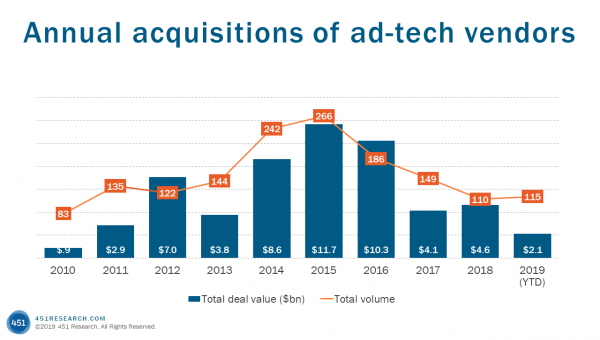by Scott Denne
The few above-market valuations captured by ad-tech companies are increasingly reserved for those vendors remaking the TV advertising market. Although the overall value of acquisitions of ad-tech firms has continued to tumble from the market’s peak in 2015, targets that can help businesses capitalize of the evolving market for TV ads are still able to find buyers at premium prices.
The most recent example comes with The Rubicon Project’s announcement that it will spend nearly half of its equity to purchase Telaria, a maker of software for managing sales of digital video ads. Although both companies operate ad exchanges and publisher-facing ad software, Telaria was built around video, with a focus on connected TV advertising. Rubicon, on the other hand, was built for display ads, later expanding into mobile and online video. Its acquisition of Telaria values the target at 4.4x trailing revenue, while Rubicon itself, a larger and faster-growing company, commands just 2x on the NYSE. (We’ll have a detailed report on this deal later today for subscribers to 451 Research’s Market Insight service).
Telaria isn’t the only ad-tech vendor fetching a premium because of its connected TV capabilities. In its sale to Roku, DataXu nabbed a higher multiple than most of its peers as Roku sought a way to expand its reach in connected TV ads (subscribers to 451 Research’s M&A KnowledgeBase can see our estimates of that multiple here). And LiveRamp, seeking to expand its identity graph into television, paid $150m for Data Plus Math, a vendor with just 25 employees.
These transactions, and the accompanying valuations, come as TV viewing (the largest nondigital ad market) repositions from over the air to over the internet. The pace of this shift can be seen in 451 Research’s VoCUL: Communications & Media surveys. In the space of a single quarter, the rate of respondents telling us they use a streaming video device (Roku, Apple TV, etc.) to watch video every day rose to 26% from 21%. Similarly, those telling us they do the same on a videogame console jumped to 17% from 11% from our first–quarter to second–quarter survey.

